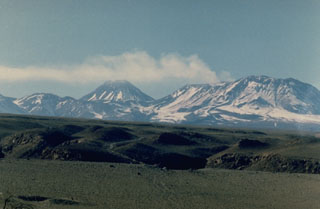Report on Lascar (Chile) — August 1988
Scientific Event Alert Network Bulletin, vol. 13, no. 8 (August 1988)
Managing Editor: Lindsay McClelland.
Lascar (Chile) Three explosions send plumes to 3 km high
Please cite this report as:
Global Volcanism Program, 1988. Report on Lascar (Chile) (McClelland, L., ed.). Scientific Event Alert Network Bulletin, 13:8. Smithsonian Institution. https://doi.org/10.5479/si.GVP.SEAN198808-355100
Lascar
Chile
23.37°S, 67.73°W; summit elev. 5592 m
All times are local (unless otherwise noted)
On 13 July, geologist Paul King (Minsal Corp., Toconao) saw two plumes emerge from Lascar. The first rose 2-3 km at 1330 and the second to 1-2 km at 1500. NOAA's geostationary weather satellite (GOES) imagery indicated that the plume blew SW ~20 km. Ash had fallen on Salta, Argentina (~300 km SE of the volcano) after the September 1986 eruption (12:4-5) but none fell there or on Argentina's high plateau after the July 1988 activity. Steam and ash emission during the morning of 15 July was followed by another ash eruption at 1400. Background activity, which has been minor steam and blue haze emission, preceded and followed the eruption. Hugo Moreno's initial inspection of photographs suggests that the 13 July explosion was phreatomagmatic, and the activity early on 15 July was phreatic with little or no ash.
Geological Summary. Láscar is the most active volcano of the northern Chilean Andes. The andesitic-to-dacitic stratovolcano contains six overlapping summit craters. Prominent lava flows descend its NW flanks. An older, higher stratovolcano 5 km E, Volcán Aguas Calientes, displays a well-developed summit crater and a probable Holocene lava flow near its summit (de Silva and Francis, 1991). Láscar consists of two major edifices; activity began at the eastern volcano and then shifted to the western cone. The largest eruption took place about 26,500 years ago, and following the eruption of the Tumbres scoria flow about 9000 years ago, activity shifted back to the eastern edifice, where three overlapping craters were formed. Frequent small-to-moderate explosive eruptions have been recorded since the mid-19th century, along with periodic larger eruptions that produced ashfall hundreds of kilometers away. The largest historical eruption took place in 1993, producing pyroclastic flows to 8.5 km NW of the summit and ashfall in Buenos Aires.
Information Contacts: P. Francis, Lunar and Planetary Institute, Houston; H. Moreno, Univ de Chile, Santiago; J. Viramonte, Univ Nacional de Salta, Argentina.

